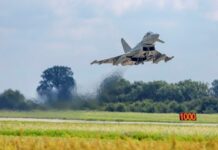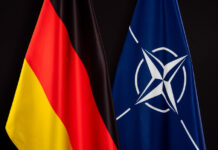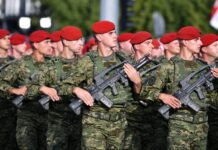The Russian invasion of Ukraine, and the consequent massive donations of materiel and ammunition from NATO nations, has once again highlighted the importance of interchangeability and how standardisation might facilitate this. The issue is relevant not only in terms of the donations to Ukraine, which includes a widely diverse range of systems and an equally diverse range of ammunition, but also in terms of ensuring interchangeability within the Alliance as nations scramble to rebuild their own depleted stockpiles.
Standardisation has always been one of the cornerstones of the NATO alliance and, at the July 2023 Vilnius Summit, one of the commitments made by the NATO nations was to “improve interoperability through transparent compliance with NATO standards”. The issue of how compliance with standards can further be developed into actual interchangeability is the topic of a recent NATO Review article, published on the NATO website, entitled ‘Turning standard ammunition into sharable ammunition’.
In the article the authors – US Air Force Lieutenant General Lance Landrum, US Army Colonel Joel P Gleason and Italian Army Colonel Giovanni Corrado – highlight what they see as the current obstacles to interchangeability, along with potential solutions, in the context of NATO’s multinational battlegroups, for which the possibility of sharing of ammunition is of particular, indeed vital, importance.
The article’s findings are based on a survey, conducted in February and March of 2023 by the NATO Standardization Office and a team from the US Army War College, within three of NATO’s eight multinational battlegroups. The primary finding of the survey was that the main obstacle to ammunition interchangeability, whether during peacetime joint training or during operations, is procedural rather than technical in nature.
Defence producers in NATO and allied nations produce ammunition and weapon systems with reference to a number of NATO standards that, at least in principle, are intended to ensure technical interchangeability. However, irrespective of the fact that most NATO nations have ratified these standards, thus facilitating the technical side of interchangeability, national policies often put obstacles in place for the practical interchange and sharing of ammunition. As an example, even if a 120 mm tank round is produced and tested in accordance with STANAG 4385, which relates to 120 x 570 mm ammunition for smoothbore tank guns, and a nation’s main battle tanks feature cannons designed to fire this ammunition, national policy often requires a lengthy and resource-intensive qualification process before the ammunition may be used. The same applies to artillery ammunition and, in particular, any ammunition to be carried by and used from aircraft, as national air worthiness requirements are often particularly strict. In addition to the technical characteristics of the ammunition itself, differences between nations in such things as transportation and storage regulations can further complicate ammunition interchange.
Another identified obstacle to interchangeability is that, even in situations where the above-mentioned procedural obstacles do not exist, or have been resolved, there is often a perception on the tactical level that ammunition cannot ‘just be exchanged’. In other words, soldiers at the tactical level are wary of exchanging ammunition with their NATO partners because they think they will violate national procedures, even if this is not the case.
Conversely, the above-mentioned survey also showed that there is a perception at the operational level that, in case of actual wartime operations, the real or imagined restrictions on exchange of ammunition would become void: a perception that is, in almost every case, incorrect.

The referenced article proposes a number of potential ways to improve the situation. First of all, the authors suggest that now is the time to make progress on standardisation and interchangeability as nations move to increase donations to Ukraine, replace equipment and ammunition already donated and, at the same time, bolster their own stockpiles. Including requirements to interchangeability and standardisation from the start, when new equipment is procured, is significantly simpler than retroactively trying to implement it, the authors point out.
Secondly, actual interchange and exchange of ammunition should be made an integral part of NATO joint exercises to allow NATO units to practise, and gain familiarity with, the practicalities of ammunition interchangeability and allow the chain of command to become accustomed to the practice. Experience from such exercises will also allow NATO and the nations to identify any gaps in current standardisation agreements and interchange procedures.
On the industry and production side of things, the war in Ukraine and the consequent dramatic increase in requirements for ammunition are encouraging defence industries to expand and increase their activities. Here, it is also important that, in so doing, the NATO nations’ industrial partners keep interchangeability and standardisation in mind.
A further possibility is for nations to take part in some of the joint procurement initiatives currently active in NATO, either via the NATO Support and Procurement Agency, or through one of the Smart Defence Battle Decisive Munitions groups. Joint procurement of the same system or ammunition by a group of nations will go a long way to reducing the technical and legal barriers, whether real or imagined, to ammunition interchangeability.
Over the longer term, these initiatives could also lead to the creation of joint, shared ammunition stockpiles that are standardised and interchangeable. In addition, this form of shared stockpiling could also reduce the lifecycle cost for each participant nation in terms of storage, surveillance and maintenance cost.
Last, but certainly not least, as hinted at above, the individual nations should be encouraged to review their own policies and procedures with regard to accepting ammunition for use by their armed forces and, if necessary, amend them to enable and encourage ammunition standardisation and interchangeability. This also includes policies and procedures for the release and exchange of data and information on ammunition to enable a faster and more detailed determination of interchangeability.
In conclusion, and to borrow from the headline of the referenced article, NATO and the nations must work together, on the technical and political levels, to turn “standard ammunition” into “sharable ammunition”.





![Hybrid navies: Integrating uncrewed capability into carrier strike The US Navy (USN) carrier USS John C Stennis (left), the French Navy carrier FS Charles de Gaulle, and elements of their strike groups are pictured sailing together in US Fifth Fleet’s area of operations. The US, French, and UK navies are all developing ‘hybrid’ crewed/uncrewed mixes for their carrier airwing capability. [US Navy]](https://euro-sd.com/wp-content/uploads/2025/09/2-HST-CdG-USN-Kopie-218x150.jpg)
![Strategic shift: UK CSG deployment demonstrates switch in UK strategic focus The UK aircraft carrier HMS Prince of Wales (foreground) sails alongside the US carrier USS George Washington during Australia’s ‘Talisman Sabre’ exercise in July 2025. The two carrier strike groups (CSGs), plus Australian Navy assets, conducted CSG integration activities. [Crown copyright 2025]](https://euro-sd.com/wp-content/uploads/2025/09/1-PWLS-GW-TSabre-CC-UK-MoD-25-Kopie-218x150.jpg)



![Ripples in the air, rupture in the ether Pictured: 1L269 Krasukha-2 jamming system. Since 2008, Russia has greatly expanded its EW capabilities, and since 2022 it has gained valuable direct experience contesting the EMS in Ukraine, where continuous innovation occurs over very short timescales. [RecoMonkey]](https://euro-sd.com/wp-content/uploads/2025/07/1L269-Krasukha-2_RecoMonkey-Kopie-218x150.jpg)

